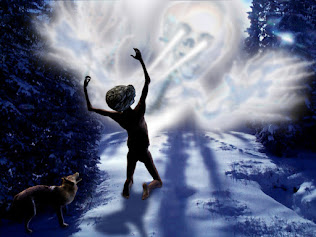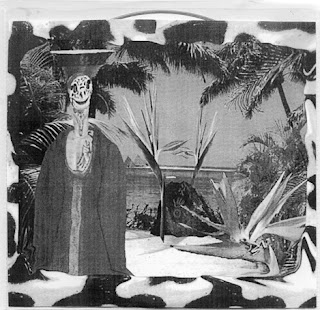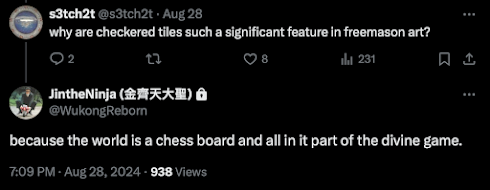"many are grateful for artificial death, that’s what the “new age” is, the precondition to men seeking death and not finding it”
- @creationistf on [X]
"the syntactical nature of reality, the real secret of magic, is that the world is made of words. and if you know the words that the world is made of, you can make of it whatever you wish."
- terence mckenna
the new age movement of the seventies brought along with it's many loosely structured philosophical systems, the contemporary sensibilities of hippie culture from the preceding decade. the acoustic and barebones tonality of folk music combined with the psychedelic spirituality of the new age era saw at its crossover one of the strangest and most intriguing musicians of the period, bobby "frank" brown. describing his vocal range as spanning six octaves [self proclaimed as the widest range to ever be recorded] and building over fifty handmade instruments all retrofitted into a singular apparatus, the "universal one man orchestra" published his theosophy not in tomes or pamphlets, but a ten track record. released in 1972, "the enlightening beam of axonda" is one of the most fascinating concept albums i have ever come across, with it's lush and peculiar songwriting aided by bobby's novel self constructed instruments, the album [as he describes it] embodies the "primitive, contemporary, and futuristic". flutes, drum machines, oscillators, synthesizers, bells, guitars, sitars, drone instruments and harps populate the album, a statement in fact of how absurdly talented he was as a solo performer and innovator [he also claims to have designed his own portable synthesizer two years before the minimoog was released].in bobby's own words, the album sets out to be “an original contribution to the field of religion & science-based on physics-not yet discovered by other humanoids. more revolutionary than einstein’s revelations of newtonian physics – the application of this physics will perhaps [in fact] lead to the most significant change in the history of humanity (plus, total religious unity)". the scale and ambition of the album is on full display in its narrative structure, with commentary on the experiences of a character called johnny [who i assume to bobby himself] and his journey from ignorance to enlightenment, filled with extensive travel, meditative inquiry, contact with extraterrestrials, exotic metaphysics, and a final prophecy for the future of our world [topics that on the surface resemble those found in magma's albums and their mythology of kobaïans, with more distinct spiritual themes]
deciphering the lyrics that bobby himself performs in grandiose style proved to be a huge difficulty, owing to the unorthodox cadence of his delivery. with no lyrics officially available, i have done my best to grab onto whatever i could discern from the songs, and piece them together with the moments of clear narration and exposition sprinkled throughout the album.
the first two songs on the album, "i must be born" and "my hawaiian home" take us through johnny's journey from a state of universal oneness to forgetting his own essence, and as a result being born into the world [literally].
forgetting heavens infinitely blissful vision of oneness, johnny was born.
the notion of individuality and the ego [i] arising from ignorance is a commonly shared one in non-dual philosophies in asia [enlightenment in paths like advaita vedanta entails the shedding of this ignorance of one's true nature, and by this reuniting with the one true essence of all that exists]. the second song then transforms into a love letter for the islands of hawaii, with johnny proclaiming his fondness for the waves, the scent of the air, the fruits and flowers. to just breathe the air at home for him was nothing short of ecstasy. however, even with all the beauty and attachment he reserves for his island home, johnny had a calling from beyond the shores.
upon graduating from high school, johnny had the intense desire to work his way around the world, and although going to leave his island home, and his girlfriend bran, he felt he had to go.
the third song "mama knows boys a rambler" goes into his experience of traveling from his home through canada and then eventually arriving at new orleans, lamenting about how much he misses his girlfriend, and although he reassures her that he longs for her company even now, he must travel and see the world.
the traveling that johnny did caused him to do a great deal of soul searching, he often thought about the purpose and true meaning of life, by the time he reached new orleans, he was very very interested in what the many different religious preachers had to say, but he'd try to learn from all of them, here comes one now.
the next song titled "mambo che chay" details his run-ins with spiritual people from all walks of life. their words of wisdom and methods for freedom piqued johnny's curiosity. this period was one filled with merry dancing and music with colleagues and strangers alike, all brought together by their common search for meaning in a world that seemed to make less sense by the decade. johnny never could subscribe to one path, for he found much value in the words and teachings of almost everyone he came across. how could he close himself off to truths he saw as real, yet veiled to others by virtue of their adherence to a path and not through self discovery? this struggle for coherence in a fractured setting of spiritual teachings compelled johnny to find his own answers, and so he went into the forest in solitude.
johnny felt there was truth to be found in every spiritual message, he saw how often the followers of jesus, buddha and krishna and many others refused to accept any truth other than that written by their particular leader, and although johnny could see that it was mainly due to their egos quest for immortality, he thought if all religions of the world would ever come together, the question bothered him so much, he decided to leave new orleans and go deep in the forest and see if he could find the answer.
the fifth track titled "oneness with the forest" describes johnny's encounter with god [of the spinozist type], describing his communion with the divine as a sweet calling, reminded of what he had forgotten, and so in realization was treated to with joy and comfort. he sees himself in his surroundings, and much of the world within him. "i can feel you" he affirms to the paradise that surrounded and comprised him.
forgetting about his own self centered thoughts , johnny became so in tune with the forest that he could feel its very pulse, and this gave him an amazing sight, he could see the plant life and trees breathing, and even the rocks, and yes even all of the atoms of everything moving, choosing, conscious, definitely alive and viewing life in their own particular way. and johnny was enraptured in pure compassion as he listened to the wind sing of its lust for life and its fear of death.
the track "tiny wind of shanol" further narrates johnny's enlightenment, describing it as life slowing down yet more alive than ever before, he then mulls over his complete return to this absolute essence in death, describing himself as a feather in the flock, finally gathering on the wings of god. he must reject such a fate for now, and although separated, he now has the eyes of the celestial, one that sees the undeniable truth of oneness in all that exists as he sings in gratitude "her eyes, her eyes, her eyes, they are mine". his newfound goal of gifting these eyes of truth to every conscious being manifested in the idea that in the field of space that occupied the gaps between the smallest of subatomic particles would lie the key to extending this knowledge to all of humanity.
as johnny witnessed the tiny wind discovering the vision of the all-perfect, unchanging truth, he thought of how all life forms could experience his bliss, but they were not limited by the sights and thoughts of their physical form, and now johnny knowing that all forms of matter are both alive and conscious realized that there was everything so close to the truth, but were so far away. then he thought of something that would change all of that, the "unifying area", that place that defies time and space, smaller than the smallest piece of matter in the atom, but in every atom and everywhere in the entire universe at the same instant, and his recognition in use will be mankind's greatest discovery, the key to the future and present.
the seventh track titled "bray" sees johnny invite us to follow him through the chambers of the atom, like entering a cave system full of wonders and treasures. he urges us to go deeper and deeper into the smallest constituents of matter till we reach a point where the concepts of time and space simply dissolve. a doorway into the omnipresent and all pervading field he names "bray" [the heart of matter]
we must move on. much much smaller than the atom, to the very threshold of time and space, it is here we will find bray.
the eighth track "axonda" lays out the prophecy revealed to johnny through his discovery of the inner chasms of the material, describing a channeling of the unifying property [bray] that fills all of existence with the aid of an instrument. a device that would completely reshape our understanding of individuality, our connection to all that surrounds us, and our very barriers that define the self. an enlightening beam shone upon all on the planet, one that transcends all those bathed in it beyond the limitations of our three dimensions that govern and delimit our understanding of the universe.
upon realizing the nature of bray, the true identity of oneness was unmasked, johnny could see clearly how the earthlings evolving consciousness and their scientific pursuits would soon lead to the building of devices and machines that allow communication without the barriers of time and space, and give all forms of life the vision of the fourth dimension, and a closer hint of guardianship, yes the coming savior, the enlightening beam of axonda.
johnny sings with joy about our mechanic savior, one whose very current will set us free from the confines of ego, attachment, and sorrow. "come on come on axonda, take me from this shivering dream".
"but i don’t want to go among mad people," alice remarked. "oh, you can’t help that," said the cat: "we’re all mad here. i’m mad. you’re mad." "how do you know i’m mad?" said alice. "you must be," said the cat, "or you wouldn’t have come here.”
- lewis carroll
the next song "going on through" takes a slightly unexpected turn. johnny now describes his ability to contact extraterrestrial beings through his communion with bray. this connection to this universal field allows him to transcend any barriers of understanding or cognition between himself and those in outer space. foreseeing a pragmatic outcome of this new medium of communication and understanding, he predicts the aid of those beings far more advanced, helping and guiding mankind into a higher form of civilization.
yes with johnny's new vision he could see how the beam of energy sent out by the machine axonda could truly be a savior for the inhabitants of earth, for it would bring on many changes that would eventually lead to total god consciousness. the first of these changes would come directly from the beam as it goes through the area of bray of all things connecting them instantly, continuously, and consciously. it reminds each lifeforms of its oneness with all others on earth thus bringing on a state of worldwide enlightenment. and this state will obviously bring the people, countries, and religions of the world into compassionate unity. but there is much much more, for it will lead to communication with animals and plants, and yes every form of matter on earth. and this revolutionary new physics, this understanding of bray would lead to communication with beings in outer space instantly, and not involving language barriers or light years even if the beings were several galaxies away. and Johnny also realized that when we begin communicating with beings much more advanced than ourselves, they will lead us in our development and distill another dimension, taking on a new form, the form of immortal light.
the second half of the album can't but help but remind me of eugenio siragusa's story of communicating with extraterrestrials invested in the spiritual awakening and progress of humanity, and stressed teachings of environmental conservation, world peace, and enlightenment . his first encounter was quite literally him being hit by a beam of light from an alien saucer, an incident which would forever change his life, culminating in a life long effort to spread their message to create the conditions of a global awakening. johnny and siragusa both talk about obtaining knowledge of a divine physics that science is yet to confirm [both bobby and siragusa claim their prophecies have come true with recent advances and discoveries in quantum physics]. the resemblance is quite uncanny.
"at a certain moment i saw how from the lower part of this luminous globe came out a floating ray of light, blue and emerald green, it had various colors, like the rainbow and was directed to a place. i didn't think that precisely this ray should penetrate me and when it penetrated me, because this ray penetrated me, i felt very happy, very happy. i got up and then i saw that this object made a huge systole and a diastole and projected itself into the horizon in an instant and shortly after it disappeared.. since then i'm not what i was before.”
- eugenio siragusa
axonda is a saucer, and the enlightening beam is one of colorful lights, that once bathed in reveals hidden knowledge and expands our consciousness. in fact, both of their descriptions of our "cosmic brothers" intents are very similar, aimed towards helping us as a species grow both spiritually and technologically. bobby's axonda is one of our own making in the future, siragusa's revolutionary device is a chariot of the gods.
the album ends with the tenth track "preparation dimension of heaven"
since johnny had been realizing all of these things so completely, the essence of his very being was actually transported through the enlightening dimension of axonda's reign on earth into the next, that of becoming immortal light. and after traveling through the universe, enjoying companionship with many inhabitants, he decided he was ready to go on to the dimension of preparation, where all things to ever exist come to prepare, to give up all thoughts of self, and enter into the next and final supreme dimension, yes, to completely merge into the total union with god himself. this preparation dimension is known as heaven.
marking the end of johnny's journey, he now feels he's ready to fall into the embrace of god. finally returning to his true essence, to the heaven he was in before he was even born. "when we finally reach the gates of heaven, but now we know just who we are, we feel the bliss of all creation, immortal travelers to any star, for now we know, and i can feel the joy of leaving, my spirits soars you know its real, and we've been through all the changes, as a man again I'll gladly be" sings johnny, now free and true to his own nature, and self assured that even if he were to be born again, he would gladly be, for this gnosis is one that can never be shed, and so forever is he bestowed with the eyes that see what really is.
johnny knew he had all the things to eventually make his preparation and totally merge into the all perfect loving god, but first he wanted to go back to the earth and complete his life as a man, and even though he had some thoughts of doing good works to help the condition of the world, he knew of its perfect and totally blissful future. and yes, he even knew that the present was totally perfect and the way it should be. and so he came, filled with love for the world, the way it is now.
for all of its weird and borderline outsider moments, this is a beautiful record in every single way. with bobby's breathtaking vocals guiding you as he walks through his vision of utopia and interstellar peace is unique and undeniably singular in both its scope and execution, there is nothing quite like it anywhere else. the use of sitars, harps, flutes, and other instruments fit so well here, a reflection of the strangeness of the story [or prophecy] the album tries to convey. and for all the aversion to new age aesthetics and philosophy today, the album works like a time machine back to the strange seventies. a string of ideas and musical influences that are held together by immaculate solo musicianship, the enlightening beam of axonda stands tall in solitude as a work like no other, a courageous, intriguing, and bizarre listen that repeatedly invites you to explore the strange worlds and ideas that bobby "frank" brown downloaded into his mind upon satori.









.jpg)































